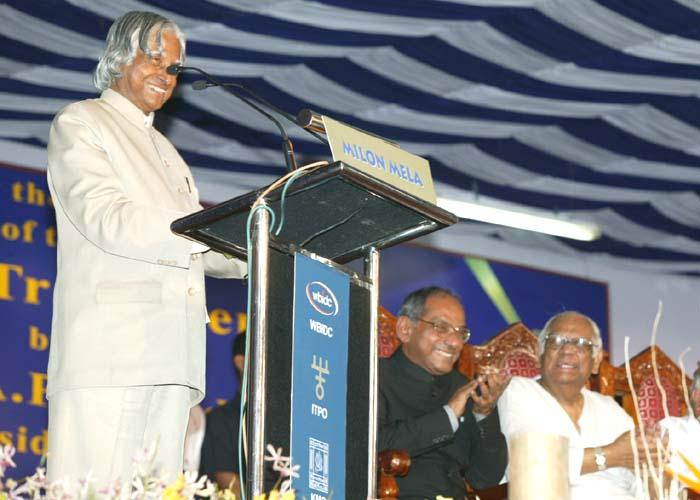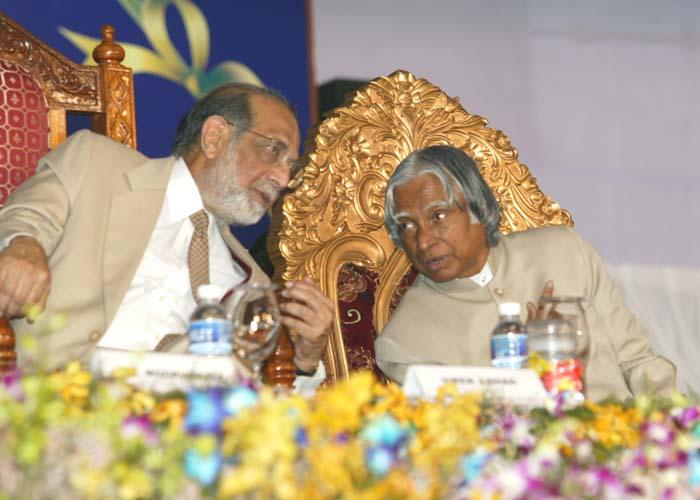Address at the Laying of Foundation Stone of the Kolkata Trade Fair Complex
Kolkata : 27-02-2004
DYNAMICS OF DEVELOPMENT
I am delighted to participate in the foundation stone laying ceremony of the Trade Fair Complex for Kolkata. The Trade Fair provides a platform for a wide range of business opportunities by showcasing technological strength in different sectors of the economy. I greet the State Government for taking this initiative and creating this complex, which will become an important business promotion center in eastern India. When I see the industrialists, entrepreneurs and connected members I was thinking what thoughts I can share with you. I will be talking to you about the "Dynamics of Development".
Law of development
Last two years, I was studying the development patterns and the dynamics of connectivity between nations, especially in trade and business. As you all know the world has few developed countries and many developing countries. What is the dynamics between them and what connects them? Developed country has to market their products in a competitive way to different countries to remain as developed country. The developing country to get transformed into developed country; they too have to market their products to other countries in a competitive way. Competitiveness has three dimensions: quality of the product, cost effectiveness and supply in time. Indeed this dynamics of competitiveness in marketing of products by developing and developed countries is called the law of development.
Our technological strength
India is today a developing country and we have a vision to transform India into a developed nation by 2020 using technology as a tool. With the growing economy and strong internal market, India is destined to make competitive products using technological innovations. Software and Pharma products have shown the lead. I see the emergence of steel technology, space technology and defence systems going to the international markets in addition to conventional products. The initiatives taken in solar farming to generate energy, desalination plants to generate drinking water will soon be mission mode programmes offering a large business in India and outside.
Small and Medium Scale Industries / Enterprises
The small-scale industries sector plays a vital role in the growth of the country. It contributes almost 40% of the gross industrial value added in the Indian economy. It has been estimated that the turn over to capital employed is approximately 4.62. The small-scale sector has grown rapidly over the years. The number of small-scale units has increased from an estimated 0.87 million units in the year 1980-81 to over 3 million in the year 2000.
SSI Sector in India creates largest employment opportunities for the Indian populace, next only to agriculture. SSI Sector plays a major role in India's present export performance. 45%-50% of the Indian Exports is contributed by SSI Sector. Direct exports from the SSI Sector account for nearly 35% of total exports. Besides direct exports, it is estimated that small-scale industrial units contribute around 15% to exports indirectly. This takes place through merchant exporters, trading houses and export houses. It would surprise many to know that non-traditional products account for more than 95% of the SSI exports.
The product groups where the SSI sector dominates in exports are sports goods, readymade garments, woolen garments and knitwear, plastic products, processed food and leather products. The strategy for enhancing the exports of goods and services from SSI Sector has to be based technology upgradation, value addition techniques, credit support and export marketing zones. Big industries should ensure timely payments for the products they receive from small scale industries. Also Trade Fair authorities should find from the international traders where Indian SSI's can fare better in global competition in areas of quality, quantity and schedule. This promotion will enable the SSI industry to grow much faster towards its target of 5 lakh crores of export performance by the year 2020. The Small and Medium scale industries need an exclusive umbrella organization to promote productivity and market their products including exports.
I was told that 10% of our small scale industries are sick. I would recommend that these units can be studied for enabling retrieval of some of the ailing units so that they can contribute towards our growth in GDP. The Trade Fair authorities can help them by finding appropriate market for their products from both national and international customers.
Conclusion
The Trade Fair Complex named as Milon Mela should become a catalyst for increased trade and visibility for Kolkata as a business destination driving investment and growth not only in the areas of manufacturing and also in ancillary industries. This will also enable promotion of knowledge products in the state. The trade fair complex will raise the hope and aspirations for different industries to field their products in a competitive environment. With growing economy Kolkata is advancing in number of areas with technological innovations. I suggest the Kolkata industry must develop quality products in time and cost effective manner, for becoming globally competitive and must penetrate into entrenched market. Trade fair can take a lead role in creating the product market linkages for our industry. Transforming India into a developed nation needs wealth generation. Small and medium scale industries should provide the required momentum for this mission.
I wish early completion of this Trade Fair Complex leading to economic prosperity of the eastern region.
My best wishes.


